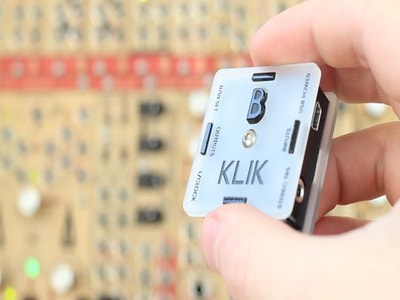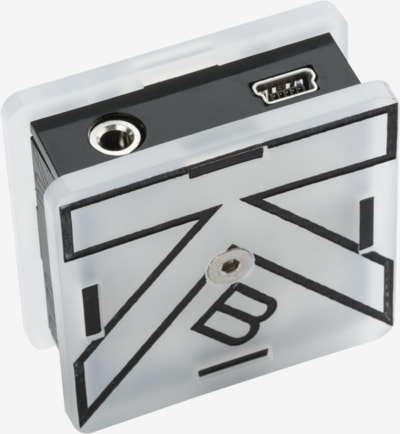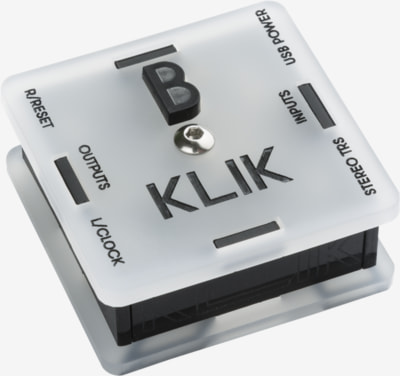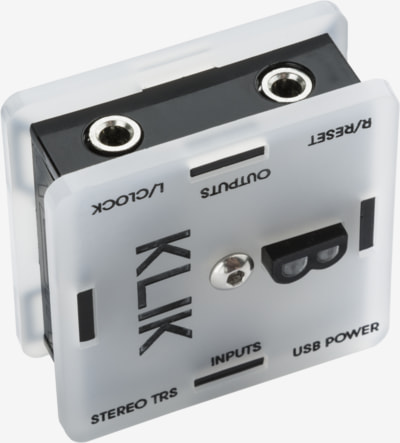KLIK
Convert audio line level to modular clock/trigger/gate
Klik is a synchronization device that enables you to make analog, rock-solid sync signals from your computer and your HW synths. The KLIK revives the old-school sync technique of using an audio track for synchronization purposes. Record your synths exactly on the grid into your DAW while compensating for the latency of your sound card. Jam really tight between your computer and your HW and add groove to your clock.
Record your synths exactly on the grid
The KLIK converts audio line level (or headphone) output signals from any sound card and makes perfect synchronization pulses at the modular level.
KLIK converts two signals (left and right input) - typically the clock and reset signal. The reset signal also has a button that you can use to re-sync your HW or send manual gate signals. You can send rhythmical triggers thru the KLIK as well.
With KLIK, you can use any channel of your soundcard or repurpose the unused headphone jack on your MacBook by creating an aggregate device. Or use an old mp3 player as a stable clock source with presets!
And as a bonus, if you run any audio signal thru the KLIK to apply a harsh bitcrushing effect!
Please note it is designed to only transmit clock / trigger / gate information. Its output is either low or high 0 or 5V. It doesn't output continuous CV signals.
Features
- TRS 3.5mm stereo line-level input
- 2 x TR 3.5mm mono outputs
- 0 or 5V trigger gate outputs
- all jacks are overvoltage / polarity protected
- Manual button gate for R / Reset channel
- Led indication per channel
DAW integration
BITWIG
Version 2.0 and further has a built-in HW CLOCK device that we collaborated on and meant to be interfaced with the KLIK.
ABLETON
There is a simple method of sending pulses from a drum machine; see the Ableton project below. I am sure someone will make max for live object for this, which will be even better – already talking to somebody about that.
CUBASE, LOGIC, PROTOOLS, ETC.
Not tested yet – a similar method to Ableton should work (download the Ableton project to get the sync samples)
Technical details
- dimensions: 44 x 44 x 20 mm
- mini USB B power 5V (overvoltage / overcurrent / polarity protected)
- current draw <10mA
- user manual pdf
- press release pdf
- Ableton project – the drum machine method (includes pulse samples)
DIY kit
You can build your own Klik with our DIY kit. Go through the complete assembly guide below and make sure that you understand all the steps.
- DIY KIT DISCONTINUED
- complete assembly guide pdf v1.0
- schematics and board diagram pdf v1.0
Audio-based clock vs. MIDI clock
We’re NOT suggesting you to stop using midi clocks! They’re awesome for a lot of stuff, but sometimes other methods are more suitable.
So what is the advantage of the audio clock in comparison to the midi clock? Well, midi clock is a protocol where there are 24 clock messages sent in the duration of one-quarter note, which is 6 messages every 16th note. Each of these messages takes about a quarter of a millisecond to transmit in the serial line at the defined speed of the MIDI protocol.
MIDI clock works great for most of the stuff, but converting it to an analog clock requires another device with a micro computer in it, which converts the serially transmitted message to the pulse information.
At the beginning of the process, the computer has to determine when is the right time to send the midi clock. It then goes into a queue of midi messages and is transmitted as soon as possible. On the side of the receiving device, the clock has to be interpreted and calculated to see what is the response of the device to the clock. That is a lot of computational work for information that is of a binary character saying simply “NOW”.
With synchronizing through audio, all that stuff is being skipped. The audio processes in the computers are rather high priority because even a slight shift of a quarter millisecond between the audio channels can cause phasing artifacts. Besides that, the MIDI clock cannot be shifted back and forth (common feature audio track delay / pre-delay) and most likely is not the best idea to put a groove on it.




